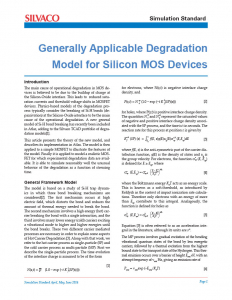Generally Applicable Degradation Model for Silicon MOS Devices
Introduction
The main cause of operational degradation in MOS devices is believed to be due to the buildup of charge at the Silicon-Oxide interface. This leads to reduced saturation currents and threshold voltage shifts in MOSFET devices. Physics-based models of the degradation process typically consider the breaking of Si-H bonds (depassivation) at the Silicon-Oxide interface to be the main cause of the operational degradation. A new general model of Si-H bond breaking has recently been included in Atlas, adding to the Silvaco TCAD portfolio of degradation models[1].
This article presents the theory of the new model, and describes its implementation in Atlas. The model is then applied to a simple MOSFET to illustrate the features of the model. Finally it is applied to model a realistic MOSFET for which experimental degradation data are available. It is able to simulate reasonably well the unusual behavior of the degradation as a function of stressing time.



